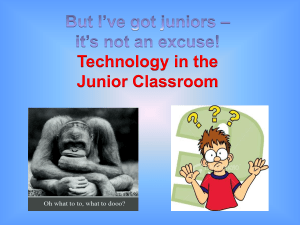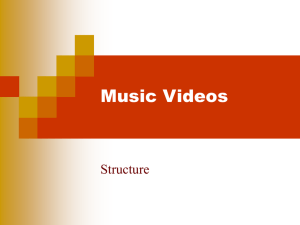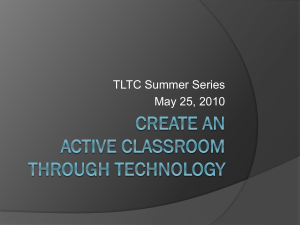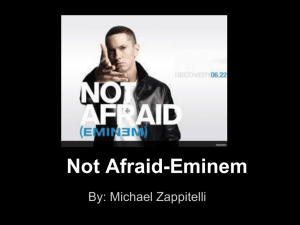Teaching the Music Video Brief
advertisement
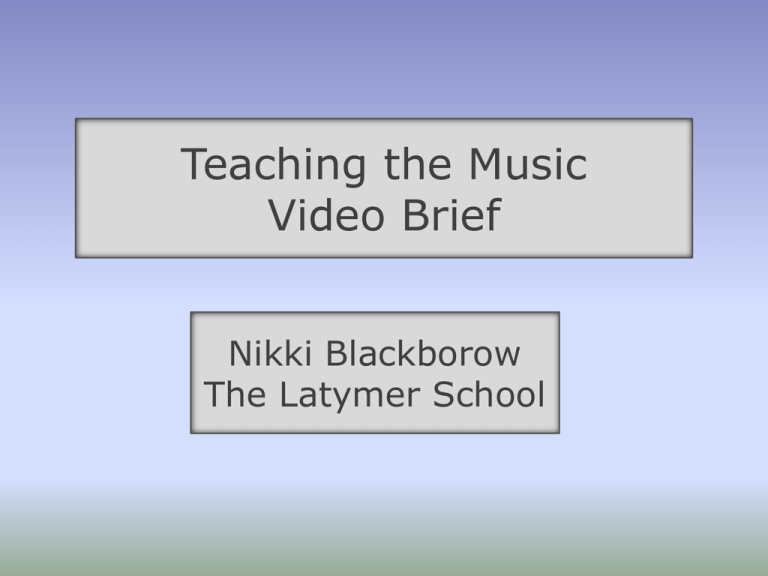
Teaching the Music Video Brief Nikki Blackborow The Latymer School Web/video Resources Our blog: http://latymermediamusicvideobrief.blogspot.com/ All links and illustrative images, videos and playlists, production work examples, student blogs, production templates, examples of treatments, storyboards etc can be found here on the blog Latymermedia Longroadmedia Hurtwoodhousemedia Coombemedia Outline of A2 course June (of Year 12) – Dec: Music Video Brief G324 (AS Brief: Film Opening sequence) Jan: exam leave Feb – May: G325 Critical Perspectives (Contemporary Media Regulation: Film and The Press) June: exam leave Organisation of unit G324 June – July: Introduce Music Video – form and style. Teach construction and performance. Use workshop video as a ‘prelim’ task. Focus on practical/creative skills. Students start their blogs. Sept – mid Oct: Teach music video theory, ancillary tasks and wider issues. Set individual research and planning tasks for homework, one task per week Mid Oct - Nov: Group research, planning & production work. Dec: Audience screenings, evaluations and self/peer assessment. Agree levels and marks. Jan: Teacher comments, produce compilation. Submission of coursework Teaching Music Video Summer Term of Y12 ideal time to start this unit 1st few lessons - lots of exposure to range of music videos Aim - to build up confidence with terminology and increase understanding of the how and why of construction Introduce a simple analysis framework Students should understand that music video is a distinctive form Useful to compare/ contrast to other forms – film, TV advertising, trailers etc Theory/ theorists Andrew Goodwin ‘Dancing in the Distraction Factory’ 1992 Carol Vernallis ‘Experiencing Music Video: Aesthetics and cultural context’ 2004 -Both available on Amazon -Ensure the theory is accessible for students – cut it down to one page of theory for each theorist – can they use/apply it? If not, it’s not worth doing. Other Resources Essential Books: Pete Fraser’s ‘Teaching Music Video’ (available from the BFI + Amazon) ‘30 frames per second: ‘The Visionary Art of the Music Video’ (Amazon) Inspirational DVDs: Director ‘best ofs’ eg The Work of Director Michel Gondry (Amazon) Latymer Music Video recent successes 2008 2 BBC Blast winners in Music Video category 2009 ‘I kissed a Boy’ 2010 ‘Voodoo Child’ 2011 ‘The Fix’ Teaching + learning The new syllabus encouraged a re-think on skills development, approaches to creativity and professional practices: 1 day practical workshop each year Focus on performance, camera and editing Lip sync practice for all Understanding of structure and form Quality learning experience – stretch & challenge Plus: Analysis of music videos, album covers, websites A focus on visual/creative planning from outset Awareness of evaluation tasks from outset Pitching process highly significant Where to start Start with your students and what they know Discussion – everything they know about music video Question – what makes a music video a music video? Conventions – big list – what do they think music videos have in common Students research and choose a music video they would consider to be the best example of the form Screen them if possible, students explain their choice Functions of a Music Video What job does a music video do? Look at music television, online/ viral, sales and promotion, video cds, compilations, synergy with film How has this changed over time? Impact of new technologies over last decade History of music video (with youtube clips for illustration) Copyright issues Alternative forms of music video – literal, lip dub and other fan based material Wikipedia – good place to start Illustrate with youtube clips – there are plenty to choose from! Music Video analysis •Key point – to explore the relationship between the lyrics, the music and the imagery • Pick your compilation for lessons around the concepts you want to illustrate • Use the analysis framework provided • Students apply the same analysis framework for a video of their choice • Prepare an analysis of a video of their choice for their blog and present in class • Post frames from their chosen video to illustrate points made 3 useful examples of narrative/ performance music videos Britney Spears ‘Baby One More Time’ 2. Busted ‘What I go to School For’ 3. Wheatus ‘Teenage Dirtbag’ 4. She + Him ‘In the Sun’ 1. Available on youtube Set in school Rich for analysis Past but popular/ familiar with students Relevant and accessible Students choose their own contemporary examples for analysis/research Key area for discussion (1) - Genre Look for generic signifiers – dancing, gestures, overall look, instruments, lyrics Familiarity, recognition, pleasure for audience Genre as a tool for music video analysis – how useful/limiting is it? Compare to analysis of film – quite a different process Key areas for discussion (2) - structure Music, lyrics, iconography - how do these work together? Different relationship to film? Which code is the more powerful? Narrative, performance, concept? Artist’s role Why have these choices been made? Key area for discussion (3)– camera and editing Look at shot patterns Compare to other forms Breakdown and compare the way narrative and performance are constructed Discuss: the process of shooting each of the above the process of editing each of the above beauty shots and performance beds why certain choices are made Key areas for discussion (4) – representation Explore representation of women through discussion of: camera work, artist performance, dress, gesture, lyrics who is in control? audience – who is it for, alternative readings? changing representations over time Practical tasks to aid learning Students remake short section of a music video. Work as a class or in groups to shoot + edit the remake. Cut all sections together at the end to form a whole In pairs, choose a song and learn the lyrics. Then lip sync to song, shoot + edit the sequence Evaluate the process and the learning associated with the above – like a prelim task Practical/creative tasks to aid learning Copy a look – students recreate a still photo in pairs Play an unfamiliar track in class, & provide the lyrics. Students annotate the lyrics individually, then class discuss initial responses, thoughts around genre etc. Then students prepare a group treatment. Show the actual video and discuss Students produce a storyboard for an extract from a professional video Students create the shooting schedule for a narrative/ performance video Can use the same approach with: Marketing campaigns Album covers Band websites Magazine adverts Brand image/identity Aim to: Discuss conventions/expectations first Have a few general examples ready Focus on one/two worked examples in detail Students follow up with their own choice, tailored to be relevant to their project Provide simple framework for analysis – a few questions The more visual the research, the better Teaching the ancillary tasks One lesson each on the form and style of: • • • • • • album covers band and record label websites magazine adverts for album examples and discussion students can contribute chosen examples use each lesson to inspire investigative work Wider concepts One lesson on each of the following: Audience consumption and popular music: how audiences are targeted, audience pleasure and appeal Institutions: structure of UK music industry, who owns what, copyright issues, exhibition and distribution, impact of recent technologies Marketing and promotional campaigns Construction of image, branding Each lesson could inspire a mini investigative activity, which can then be used as individual research evidence Development of Initial Ideas Track selection Moodboard to represent chosen genre ‘Collage’ style image or photos to represent chosen target audience Logo ideas to represent record label Screen test shots of possible actors Brainstorms of early ideas for tracks Treatment to represent music video ideas Build up to a pitch to class Use the blog to illustrate the presentation and have a hand out ready Planning Students are expected to produce: a timeline a storyboard a shot list a shoot schedule a call sheet a costume and props list ongoing behind the scenes photos/video clips The Portfolio Each student has their own blog Each group has their own blog These are all linked together and to the teacher hub Research and planning tasks Provide a ‘menu’ or list of the kind of thing they must, should or could do Guided tasks work best - make them fun and visual! Suggested tasks linked to work done in class Work done outside lessons from the start Build evidence as they go along Must have evidence of each stage Research and planning evidence Blogs should be visual and analytical, with regular postings, and no unexplained gaps Research must be relevant and focused. It’s purpose should be to inform and inspire the production Individual blogs should contain evidence of individual research, ideas, skills development, and reflections Group blogs should focus on all group research, planning and production once the project is up and running Students should formally close their blog when the project is over/on the day of the deadline Evaluation Group and individual task Groups brainstorm answers and debate points in class first Each group plans their own approach Important to demonstrate development from AS and a range of technologies If presenting an answer on video, prepare answers in advance and provide rehearsal time Illustrate with pre-selected clips, and other imagery Each student in group ‘leads’ the discussion at a different point All illustrative materials linked to blog afterwards Students post their reflections plus any points missed out Give a time limit and some quiet space Videos recorded in one take Assessment Positive marking system Break down the criteria according to your project and students Is the evidence there? Interactive mark sheet Compilation DVD Candidates in sample create a ‘Dear Moderator’ final post Do anything you can to ensure the moderator’s job is made easier

